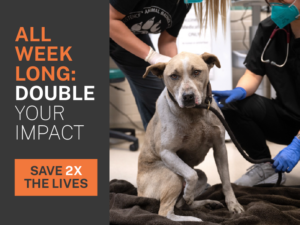When introducing a new dog to your resident dog, we recommend a slow and safe introduction. While it may be tempting to let your resident dog greet the newcomer right away, the consequences of a not-so-great first impression may have negative lingering effects.
A Sanctuary Space
- Plan a meeting outdoors while both dogs are on leash. A neutral area is better than the resident dog’s yard. Try your best to keep leashes loose and untangled.
- If one of the dogs is showing signs of stress or is being avoidant, do not coerce or force them to get close.
- Sniffing hinds is the most polite way for dogs to greet each other.
- Growling is an important, clear communication; avoid punishing a growl. Instead, let the growling be your cue to give that dog a break from the current environment.
- Limit close physical interactions to brief moments. If appropriate, take a short walk or walk around your backyard with both dogs on leash before bringing the new dog inside your home.
- Keep valued toys and chew items off the ground until you know how your first dog will react with another dog around his resources. This includes dog beds and empty food bowls.
Plan Ahead
- The first three days are crucial for the new dog. Set up a private space where they can decompress and be alone.
- Walk your resident dog separately for the first three days of bringing your new dog home. Slowly build up the time they are spending together.
- Feed separately. Each dog should have their own fully enclosed area to eat.
- Have an emergency plan just in case. If a fight breaks out, do not use your hands to break it up. If one loud, sharp noise does not break it up, douse a large amount of water in the face of the biting dog.
Be Patient
- Create positive associations for both your resident dog and the new dog. If you find you are having to tell one of the dogs “No!” often, they will likely start to feel stress around the other dog.
- Use baby gates or X-pens to help manage the environment. Keep dogs separate when you cannot keep a close eye on them, especially during the first three weeks after the introduction.
- Teach the dogs new cues, such as “go to your spot” or “back up”. This can help create space when things are getting too hectic for one or both of the pets.
We are always here to help! You can find additional behavior and training resources at pasadenahumane.org/behavior.



